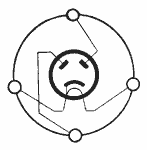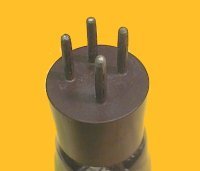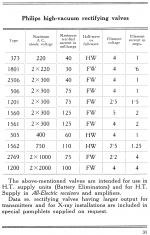
2506
|
|
|||||||||||||||||||||||||||||||||||||||||||||
|
Hits: 4032 Replies: 9
2506 (2506-Philips)
|
|
|
John Hupse † 28.9.20
14.Oct.05 |
1
The Philips 2506 is the earliest-known rectifier to use an indirectly-heated cathode. Your reference (RVF-Röhrenbuch-M1, 1947) is not very accurate in this respect. This tube was first used in the Philips 2514 receiver, produced in 1928. Its specifications are: Heizart: indirect Anodenspannung: 300 Volt AC Anodenstrom: 45 mA The Heizspannung and Heizstrom are correct represented: 4 Volt - 1 A. The production of the Philips 2506 was stopped in 1929 because of reliability problems with the heater. Successor is the directly-heated Philips 506K. |
|
Otmar Jung
14.Oct.05 |
2
Hello John Hupse. How many pins has your tube 2506 ? In your picture i count four, but how connect a indirect heated full-wave rectifire with four pins? Where is the solution? Many greetings Otmar Jung |
|
John Turrill
15.Oct.05 |
3
Greetings Otmar, I hope you don't mind me joining in this discussion; this is something that used to confuse me, also - but actually you will find many rectifier valves (indirectly heated) which only have four pins, the cathode being internally connected to one filament pin. The 2506 does have only 4 pins; and I think I'm right in saying the Philips 506K and 1861 etc. are connected similarly. Rather more modern valves such as the Mullard GZ32, 33, 34, 37 etc. are the same; it just has to be remembered the mains transformer must have a seperate, isolated filament winding!!! Hopefully John Hupse will correct or add to this for us, as his knowledge seems excellent. Hope this is of some use, anyway. Kind regards, John Turrill. |
|
John Hupse † 28.9.20
16.Oct.05 |
4
Otmar, Yes, the Philips 2506 tube has a 4-pin connector. The glass bulb however has 5 outgoing wires. The cathode wire and one of the heater wires are both connected to one of the heater pins. So the indirectly heated 2506 can be easily replaced by a directly heated 506K tube. In fact this is exactly what happened after the production of the 2506 was ceased by Philips in 1929. |
|
Ernst Erb
17.Oct.05 |
5
Dear John Thank you for your very valuable information on the tube. I have integrated your text to the tube and indicated that the information came from you. I wonder if you accept my offer that you can do such enhancement yourself by being a tube administrator? You would not have any obligation but would be able to ... Keep in mind please that I'm not regularly in the forum. My duty is to run the whole system and organisation (only) and there is often no time for helping in details. Perhaps you can tell me if there is more need to changements or addings to some tubes due to other information you gave in other occasions - if you don't accept my offer. In any case do write an eMail to me please. I will then also be able to give you more details - for instance to whom you can write in case of corrections needed on tubes (if you will not be an admin).. |
|
Jacob Roschy
17.Oct.05 |
6
Can anybody contribute an authentic datasheet with base diagram of this valve, or a picture, where the indirectly heated cathode tube is visible ? Any of the schematic diagrams of the Philips 2514 receiver shows up only the direct heated 506.
|
|
John Hupse † 28.9.20
17.Oct.05 |
7
Jacob, The Philips 2506 is well documented into tube literature. See e.g. 70 yrs of Radio Tubes and Valves (Stokes) page 117. Or the advertisement in Wireless World, December 4, 1929, adv.p. 6. See attachment for the 2506 pics. Attachments
|
|
Jacob Roschy
17.Oct.05 |
8
Many thanks, John, for these pictures,
|
|
John Turrill
21.Oct.05 |
9
John, in view of your excellent data & pictures regarding the 2506 & 506, I wonder if you or any other member has detailed information on the Philips 2769 rectifier, and/or any equivalent substitute please? Respectfully, John Turrill. |
|
John Hupse † 28.9.20
21.Oct.05 |
10
John, see your mailbox for the Philips 2769 specs Attachments
|
End of forum contributions about this tube
| Data Compliance | More Information |




